How to Attract Birds in Winter and Spot More Species
Updated: Jan. 14, 2022
Learn how to attract winter birds you want to see with these simple tips. Use these tricks to see more fliers when the temperature drops.
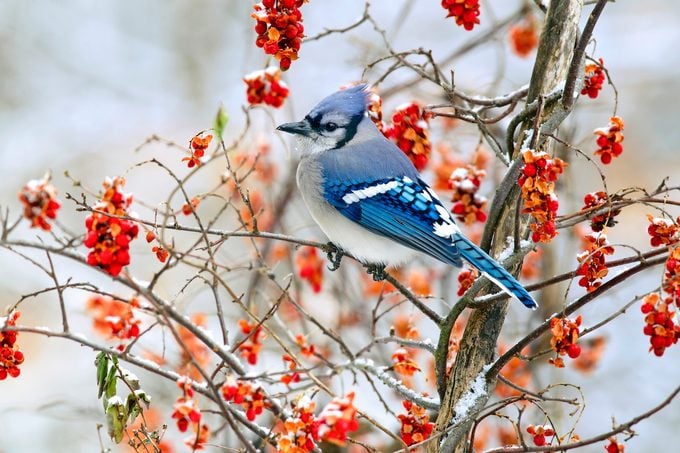
Attracting birds in winter is easier than you might think! The most straightforward advice on how to attract winter birds is to provide foods they love and offer them safe places for them to take shelter as the air gets crisp and the temps fall. Birds are even more beautiful in the midst of a few flurries, so besides helping them get through winter, you’ll also be able to enjoy their beauty in your own backyard.
Feeder activity isn’t always consistent throughout the year. You may notice an uptick in guests in the winter, because a lot of natural food is frozen or hidden under blankets of snow. Birds are generally less territorial in the nonbreeding season, too, so they are more tolerant of sharing space at the feeder. So it’s time to top off the seed supply, pour yourself a cup of hot cocoa, and enjoy the snow birds with these top tips and tricks for winter bird-watching.
Don’t miss the 51 best winter bird photos.
Focus on Feeders
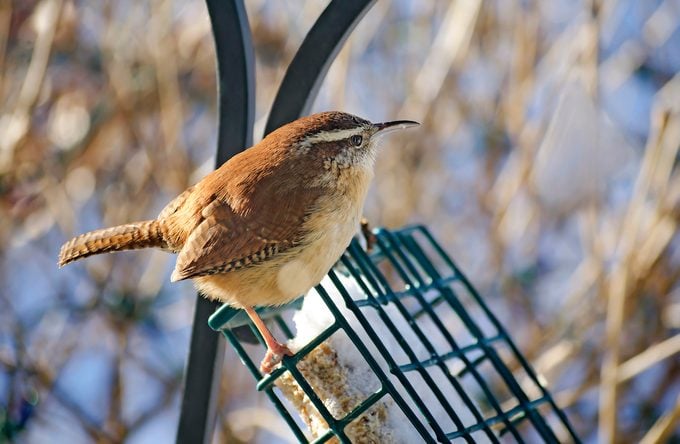
Many birds grow extra down feathers in winter. The puffed-up feathers provide insulation against the elements. Yet winter is still a battle for survival for birds. Feeders with high-fat foods such as suet and peanuts give feathered friends a boost. Woodpeckers are especially fond of these calorie-rich treats, so to attract birds to your yard, consider a double suet feeder or one with a long tail prop that allows them to use their tails as a tripod as they feed. Planting native berry bushes also provides much-needed nutrients for many species as winter settles in.
Discover the truth about 12 winter bird myths and facts.
Provide Fresh Water
Water is an especially attractive offering that will attract birds during the colder months. Adding a heater keeps your bird bath from icing over, giving birds a dependable place to drink (although they won’t use it like a birdie hot tub to warm up). Beyond the backyard, natural areas with open water are magnets for birds in winter. Congregations of waterfowl flock to large rivers and coastal areas. Use your car as a portable blind while you scope for large groups of cold-tolerant ducks, geese and swans.
How do hummingbirds survive snow and cold weather?
Add Roosting Boxes
Bird boxes are often associated with the nesting season, but nuthatches, chickadees, wrens and others will utilize them as roosting sites in the winter. Roosting boxes provide sheltered spots that are warmer than the bone-chilling outside air. Natural shelters, such as cavities in dead or living trees and dense thickets of conifers, can give a similar refuge to smaller birds such as tiny northern saw-whet owls.
Wait for Blustery Days
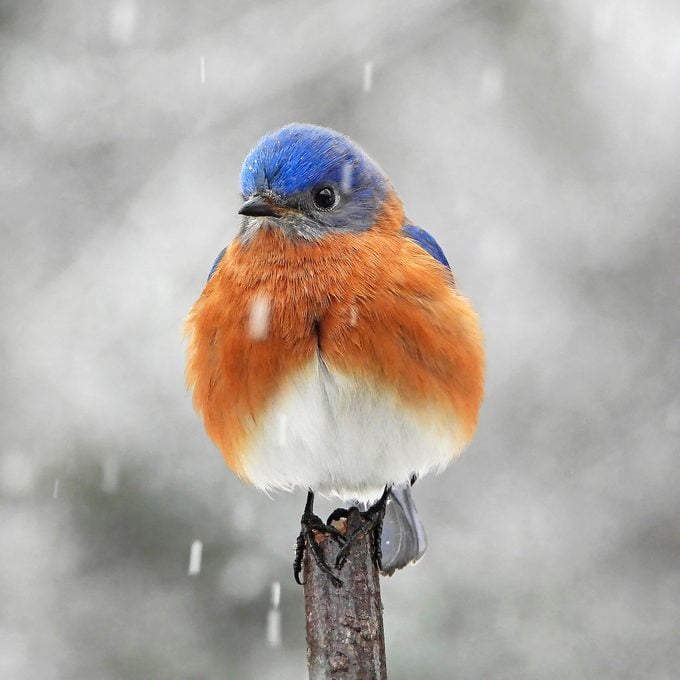
A bird’s diet is mostly from natural sources, such as berries, seeds and nuts, even when food is scarce. But blizzards and winter storms often bring visitors to feeding stations. To attract birds, bundle up and top off your feeders repeatedly after bad weather. The easy access to a birdseed buffet after a storm provides some of the best bird-watching opportunities. For example, flocks of grosbeaks might ignore feeders much of the season, but they tend to show up during the worst weather. Providing additional feeding stations can help accommodate these occasional large flocks.
Go for a Drive
Some of the best birding can happen from the comfort of your car. Roll your windows down and crank your heaters up. After the autumn leaves fall, the open canopy makes spotting wildlife a bit easier. Look for owls and hawks in the treetops as you cruise the back roads. Migrants that breed on the tundra, from longspurs to snowy owls, often find winter refuge along plowed fields and roadside ditches. Snow buntings will mix in with flocks of horned larks, too.
Welcome Snow Birds
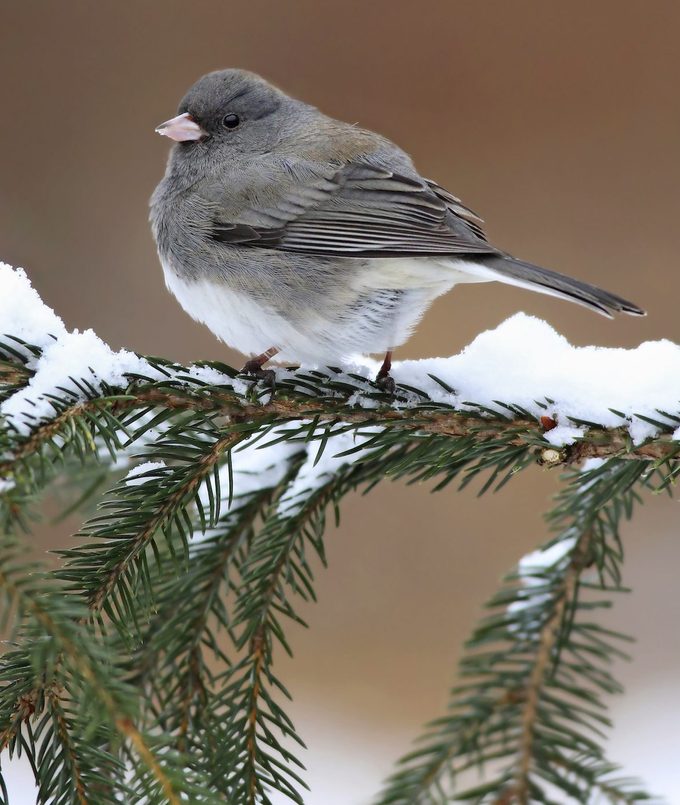
Even in the northern reaches of the continent, winter brings new migrants. Dark-eyed juncos, for example, are exclusively winter backyard visitors for many folks who like to attract birds. These sparrow relatives are predominantly ground feeders, but they also eat from platform trays and fly-through feeders. Look for streaked pine siskins among goldfinches—they’ll blend into the goldfinches wearing their more drab winter feathers. The anticipation of irruptive migrants is another winter highlight—you never know if it will be the year a redpoll shows up in your neighborhood.
Where do hummingbirds migrate in winter?
Go Birding for a Good Cause
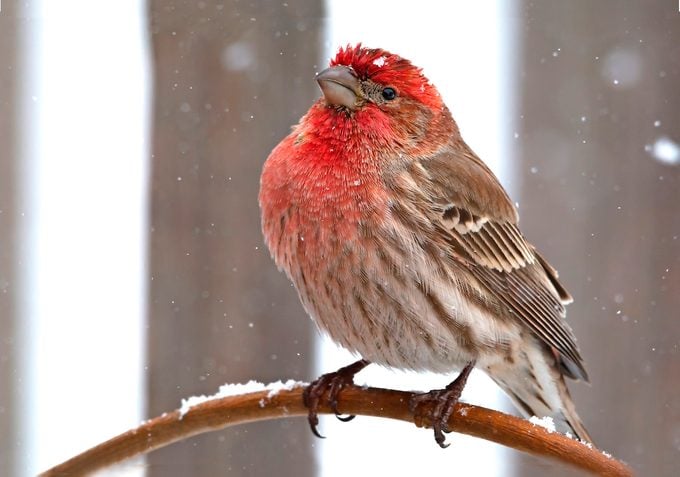
Get involved with a community science project. Project FeederWatch runs from November to April. You can count the birds in your own yard or another designated location. The Audubon Christmas Bird Count is also wonderful for the camaraderie, in addition to being one of the longest-running citizen science programs. Or opt for the Great Backyard Bird Count, an annual fourday event held each February. Beyond data collection, many of these events hold online photo contests and offer other ways to get involved and interact with fellow winter bird-watchers.
6 More Ways to Attract Winter Birds
1. Find the Right Feeder Spot: To get the most winter bird traffic, place feeders at varying heights and locations.
2. Get Crafty: Make a wreath or small container garden and decorate it with birds’ favorite foods.
3. Record It: Keep a bird journal. Jot down important details when you spot a new species.
4. Be Messy: Birds appreciate a little garden debris, like seed-pods, leaf piles and fruit that fell from trees.
5. More Seed!: An extra large tray or hopper feeder holds more seed, which means you’ll fill it less often. It’s a win-win!
6. Think Shelter: Place feeders near trees and shrubs so birds can take shelter from predators.
If you’d like to learn more about attracting birds in winter (and throughout the other three seasons), we highly recommend the book The Joy of Bird Feeding: The Essential Guide to Attracting and Feeding Our Backyard Birds by Jim Carpenter. This book is the ultimate resource for backyard birders and includes what are the best foods to offer for the specific birds you want to see, how to deter unwanted backyard guests (like squirrels), and practical tips for identifying and attracting birds.
Readers Share the Joys of Winter Birding
Our readers shared some of their best photos, and we’ve included a tip on how to attract these birds to your backyard in winter.
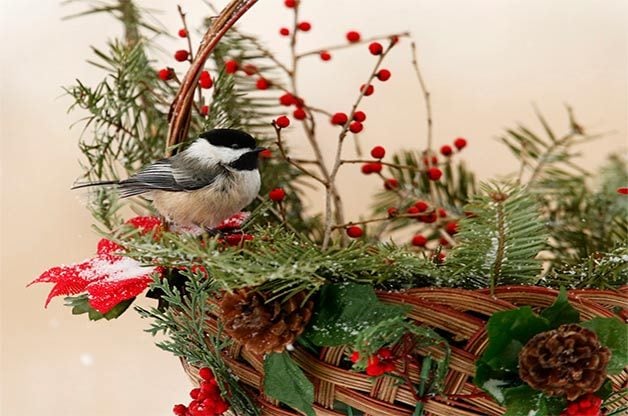
1. Black-Capped Chickadee
A black-capped chickadee posed on a festive basket that I made last winter. —Respah Mitchell of Exeter, Maine
Attract with: willow, alder and birch trees for nesting and suet, sunflower seeds, peanuts at hanging feeders and window feeders
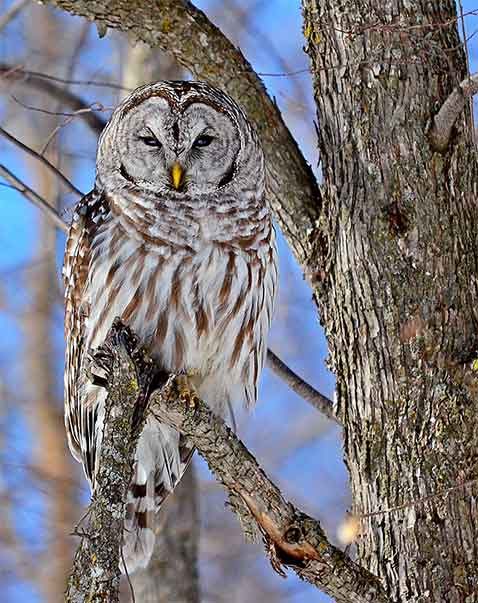
2. Barred Owl
This barred owl came to our yard for a few days last winter and hunted some of the red squirrels. I was able to get kind of close to it as it perched in this tree. Unfortunately, two days after I captured this shot, I found the bird next to a snowbank. I feel this photo is something of a memorial to it. —Laurie Painter of Silver Cliff, Wisconsin
Attract with: nest boxes in mature, dense trees
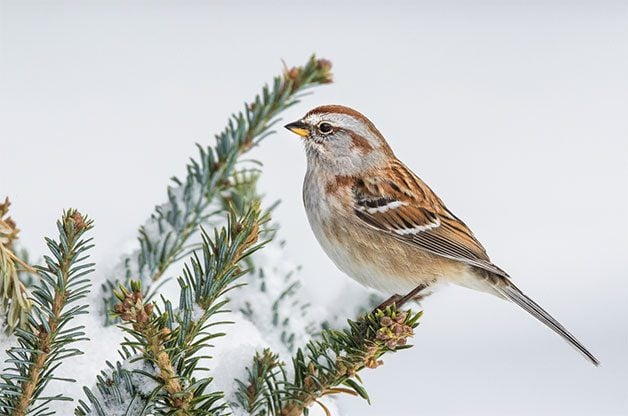
3. American Tree Sparrow
Some days, the winter skies are drab and full of snow clouds. Yet it’s on those dark days that mellow colors become rich, especially when there is no light to cause contrast as on sunny days. One dark day, this American tree sparrow momentarily perched on a fir branch. I set my camera to an aperture that allowed for a lot of light to enter, so it blurred out the background. I think the image has the feel of a painting. —Laurie Dirkx of Ontario, New York
Attract with: hulled and black-oil sunflower seeds, thistle, millet, peanut hearts
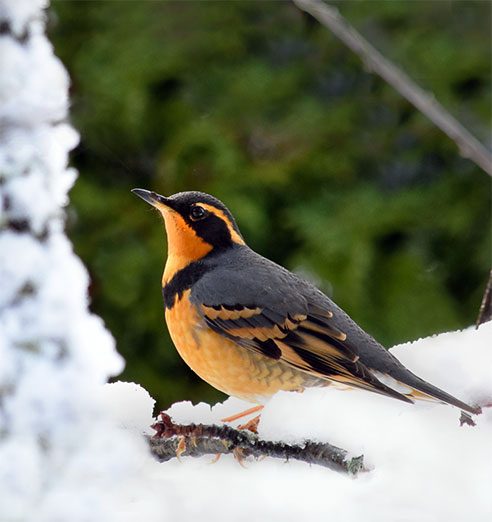
4. Varied Thrush
I waited all winter for this noble varied thrush to come close enough for a portrait. The bird skirted the edge of my property, just outside of camera range, searching for food. It wasn’t until a rare snowfall covered its feeding grounds that it came to see what I was serving at my feeders. —Sally Harris of Carlsborg, Washington
Attract with: hulled sunflower seeds in ground feeders, suet, fruit, mealworms
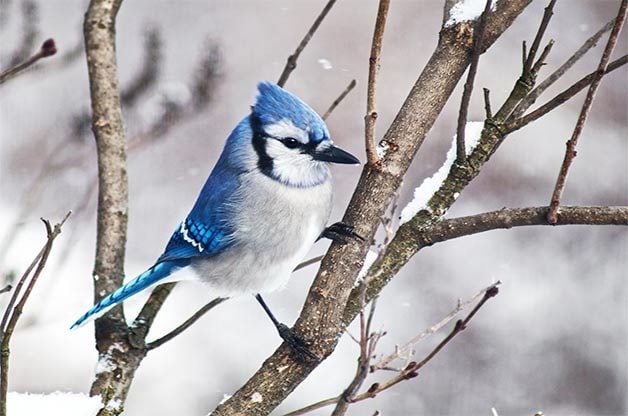
5. Blue Jay
Brilliantly colored blue jays are some of my favorite winter birds. This particular one looks like it’s trying to show off and say, “I’m going to pretend I don’t see you taking my picture, but here’s my good side.” —Noelle Sippel of Webster, New York
Attract with: peanuts, suet, sunflower seeds, fruit, plus oak trees and bird baths
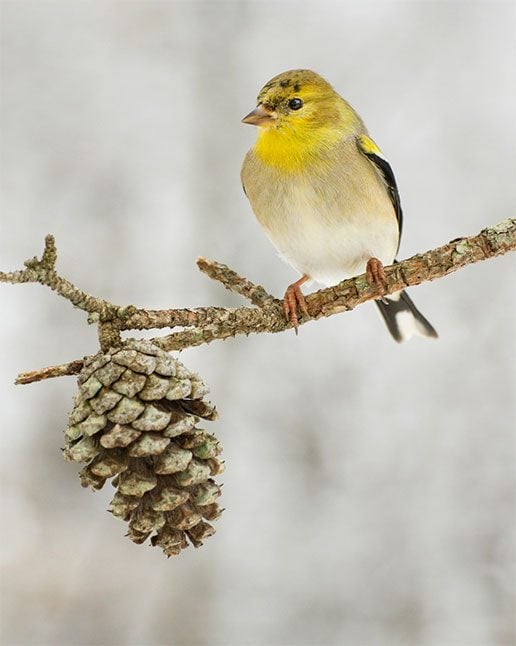
6. American Goldfinch
During the chilly months, American goldfinches travel in small flocks and dart around bird feeders. They also look for small seeds inside thistles, asters and native grasses. It’s fascinating to watch a male goldfinch transform from bright yellow to drab brown each year. —Matthew Cuda of Tobacoville, North Carolina
Attract with: black-oil sunflower seeds and thistle (nyjer) in finch feeders. Also add native thistle and milkweed plants to your yard.
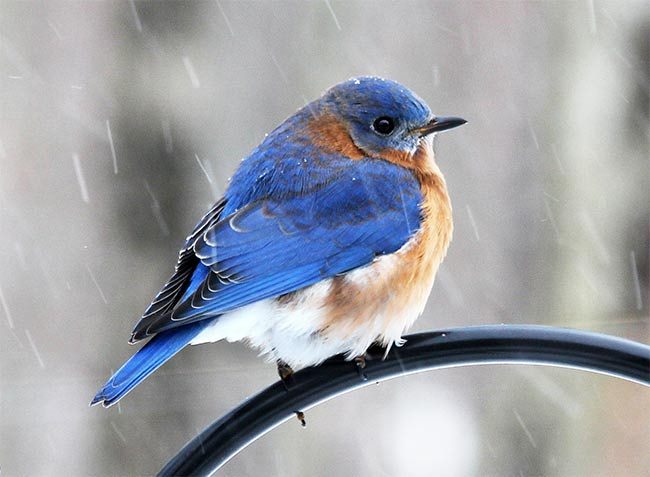
7. Eastern Bluebird
I captured this photo of a male eastern bluebird at the start of a winter storm. Cold weather creates some challenges for a bird’s survival, so I always do my best to provide the necessities—food, water and shelter. —Robert Merrifield of Amston, Connecticut
Attract with: mealworms or fruit in a platform feeder

8. Evening Grosbeak
The evening grosbeak is one of the most dramatic winter finches to come frm Canada to northeastern Minnesota’s coniferous forests. These colorful grosbeaks are a favorite at my feeders. Large flocks of them can be seen at the Sax-Zim Bog, which is north and west of Duluth. This species seems to have spread eastward about a century ago as box elder trees and other winter food sources became more plentiful. —Donald Kaddatz of Mora, Minnesota
Attract with: black-oil sunflower seeds in tube, hopper or platform feeders

9. Great Gray Owl
One morning, I heard crows cawing like crazy in my front yard. Knowing it meant a hawk or an owl was around, I ran outside in my housecoat and winter boots. Sure enough, a huge great gray owl flew across my driveway and landed on a fence post near the side of the road. I sat in a snowbank and took photos of it while it preened itself and stared right back at me. I love the intensity of its stare and the gorgeous patterns on its feathers. —Leslie Abram of Codrington, Ontario
Attract with: nest platforms in interior forests
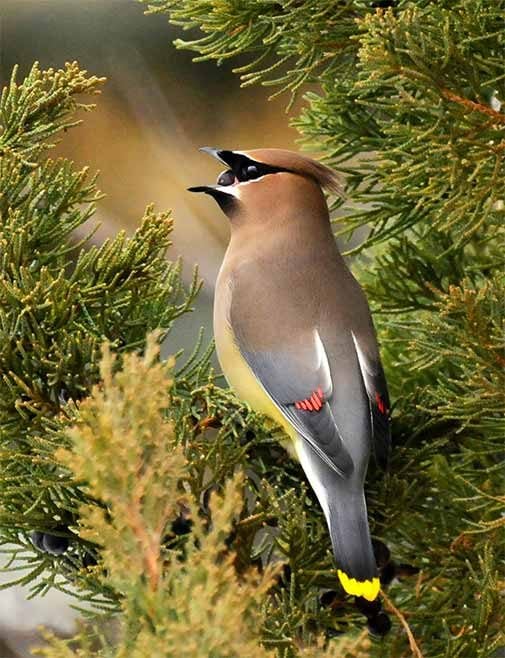
10. Cedar Waxwing
I watched this cedar waxwing munch on some berries on a cold December day at Frederik Meijer Gardens in Grand Rapids, Michigan. —Angela Rattinger of Fruitport, Michigan
Attract with: native, fruit-producing trees and shrubs, like serviceberry, juniper, hawthorn and winterberry
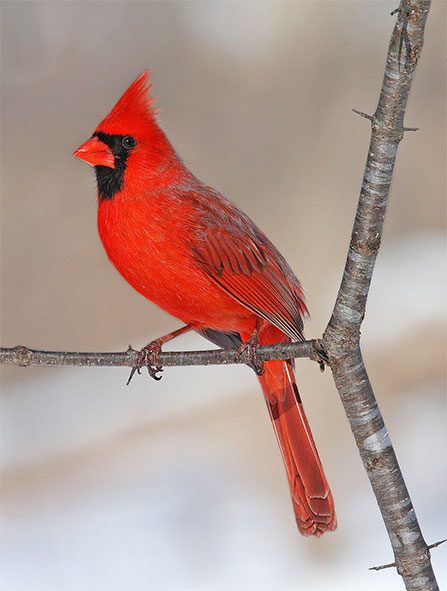
11. Northern Cardinal
On a below-zero day, I took this photo of a cardinal while I was in a blind at Camden State Park in southwest Minnesota. To attract these birds, I learned to mimic the cardinal call, and within minutes of me whistling, they came and landed near the black-oil sunflower seeds I put out. —Jon Wood of Marshall, Minnesota
Attract with: sunflower seeds, safflower, cracked corn, peanut hearts, backyard undergrowth and thickets for nesting
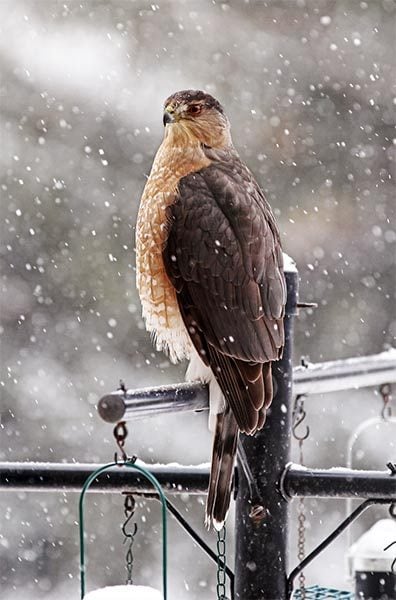
12. Cooper’s Hawk
A Cooper’s hawk stopped by our bird feeder last winter. All of the birds, squirrels and chipmunks quickly scattered. —Rodger Boehm of Winnetka, Illinois
Attract with: tree-filled habitats, forest edges
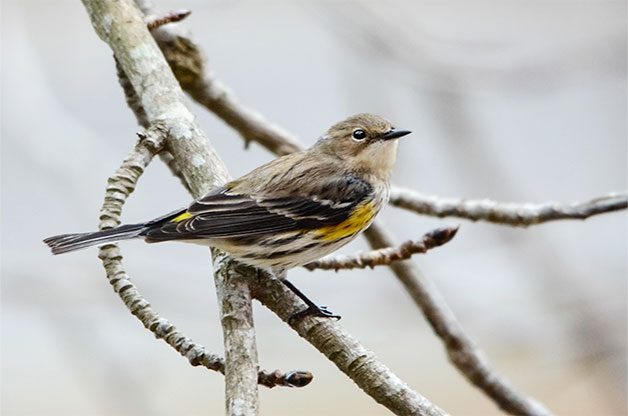
13. Yellow-Rumped Warbler
This is one of my favorite photographs of a yellow-rumped warbler. It was winter and there were no leaves on my trees. The bird hopped from branch to branch, posing for me before it flew away. —Betsy Moseley of Zellwood, Florida
Attract with: bayberry, Virginia creeper and other native fruiting shrubs and vines
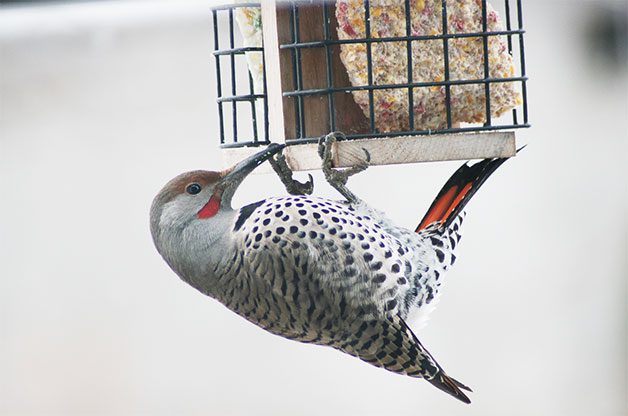
14. Northern Flicker
We love feeding and watching birds year-round at our home. Each winter, we are lucky to have the most colorful Northern flickers show up to gobble down the suet. —Karen Osadchey of Ridby, Idaho
Attract with: suet, safflower, peanuts, cracked corn
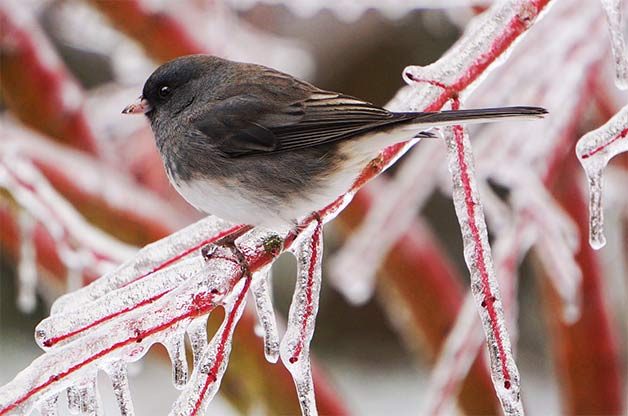
15. Dark-Eyed Junco
I see dark-eyed juncos almost daily in my backyard. Although I know they can be found on much of the continent, it seems as if they are all right here in North Carolina! The juncos mostly feed on the ground, but occasionally they fly to the feeders or use my little birdbath. I think they’re adorable! —Kimberly Miskiewicz of Raleigh, North Carolina
Attract with: black-oil sunflower seeds, peanut hearts, cracked corn, thistle, safflower seed
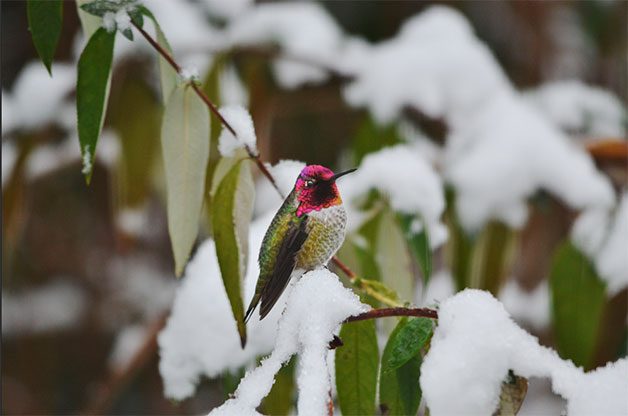
16. Anna’s Hummingbird
An Anna’s hummingbird spends winters in my yard. One day, I sat at the window waiting for the bird to light on the snow-covered butterfly bush. Eventually, the beautiful winter jewel obliged. —Kristi Gruel of Snohomish, Washington
Attract with: hummingbird sugar-water and nectar flowers
Winter Birding Festivals
From warm oases to frigid destinations, all corners of the United States offer a winter birding festival.
- Birds on the Niagara Buffalo area, New York
- Everglades Birding Festival Davie, Florida
- San Diego Bird Festival San Diego, California
- Space Coast Birding and Wildlife Festival Cape Canaveral, Florida
- Whooping Crane Festival Port Aransas area, Texas
- Winter Wings Festival Klamath Falls, Oregon
Please check festival websites for details and any COVID-19 updates.




















